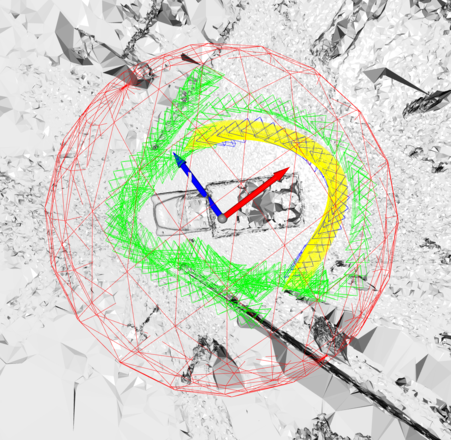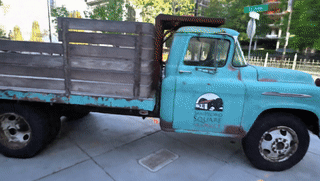| camera_inspector | ||
| camera_visualizer | ||
| colmap_runner | ||
| configs | ||
| demo | ||
| .gitignore | ||
| data_loader_split.py | ||
| ddp_model.py | ||
| ddp_test_nerf.py | ||
| ddp_train_nerf.py | ||
| environment.yml | ||
| FORK.md | ||
| nerf_network.py | ||
| nerf_sample_ray_split.py | ||
| README.md | ||
| utils.py | ||
Notice: this is a fork of The original NeRF++ implementation.
NeRF++
Codebase for arXiv preprint "NeRF++: Analyzing and Improving Neural Radiance Fields"
- Work with 360 capture of large-scale unbounded scenes.
- Support multi-gpu training and inference with PyTorch DistributedDataParallel (DDP).
- Optimize per-image autoexposure (experimental feature).
Demo
Data
- Download our preprocessed data from tanks_and_temples, lf_data.
- Put the data in the sub-folder data/ of this code directory.
- Data format.
- Each scene consists of 3 splits: train/test/validation.
- Intrinsics and poses are stored as flattened 4x4 matrices (row-major).
- Pixel coordinate of an image's upper-left corner is (column, row)=(0, 0), lower-right corner is (width-1, height-1).
- Poses are camera-to-world, not world-to-camera transformations.
- Opencv camera coordinate system is adopted, i.e., x--->right, y--->down, z--->scene. Similarly, intrinsic matrix also follows Opencv convention.
- To convert camera poses between Opencv and Opengl conventions, the following code snippet can be used for both Opengl2Opencv and Opencv2Opengl.
import numpy as np def convert_pose(C2W): flip_yz = np.eye(4) flip_yz[1, 1] = -1 flip_yz[2, 2] = -1 C2W = np.matmul(C2W, flip_yz) return C2W - Scene normalization: move the average camera center to origin, and put all the camera centers inside the unit sphere.
Create environment
conda env create --file environment.yml
conda activate nerfplusplus
Training (Use all available GPUs by default)
python ddp_train_nerf.py --config configs/tanks_and_temples/tat_training_truck.txt
Testing (Use all available GPUs by default)
python ddp_test_nerf.py --config configs/tanks_and_temples/tat_training_truck.txt \
--render_splits test,camera_path
Note: due to restriction imposed by torch.distributed.gather function, please make sure the number of pixels in each image is divisible by the number of GPUs if you render images parallelly.
Citation
Plese cite our work if you use the code.
@article{kaizhang2020,
author = {Kai Zhang and Gernot Riegler and Noah Snavely and Vladlen Koltun},
title = {NeRF++: Analyzing and Improving Neural Radiance Fields},
journal = {arXiv:2010.07492},
year = {2020},
}
Generate camera parameters (intrinsics and poses) with COLMAP SfM
You can use the scripts inside colmap_runner to generate camera parameters from images with COLMAP SfM.
- Specify
img_dirandout_dirincolmap_runner/run_colmap.py. - Inside
colmap_runner/, execute commandpython run_colmap.py. - After program finishes, you would see the posed images in the folder
out_dir/posed_images.- Distortion-free images are inside
out_dir/posed_images/images. - Raw COLMAP intrinsics and poses are stored as a json file
out_dir/posed_images/kai_cameras.json. - Normalized cameras are stored in
out_dir/posed_images/kai_cameras_normalized.json. See the Scene normalization method in the Data section. - Split distortion-free images and
kai_cameras_normalized.jsonaccording to your need. You might find the self-explanatory scriptdata_loader_split.pyhelpful when you try converting the json file to data format compatible with NeRF++.
- Distortion-free images are inside
Visualize cameras in 3D
Check camera_visualizer/visualize_cameras.py for visualizing cameras in 3D. It creates an interactive viewer for you to inspect whether your cameras have been normalized to be compatible with this codebase. Below is a screenshot of the viewer: green cameras are used for training, blue ones are for testing, while yellow ones denote a novel camera path to be synthesized; red sphere is the unit sphere.

Inspect camera parameters
You can use camera_inspector/inspect_epipolar_geometry.py to inspect if the camera paramters are correct and follow the Opencv convention assumed by this codebase. The script creates a viewer for visually inspecting two-view epipolar geometry like below: for key points in the left image, it plots their correspoinding epipolar lines in the right image. If the epipolar geometry does not look correct in this visualization, it's likely that there are some issues with the camera parameters.


